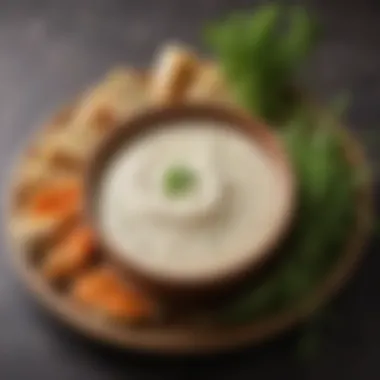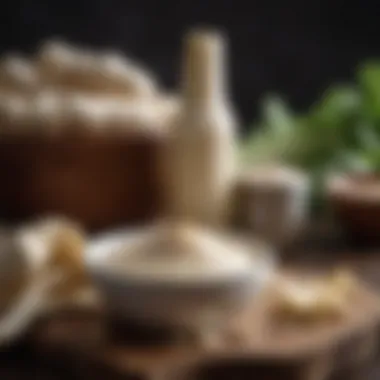Exploring the Depths of Horseradish Dipping Sauce


Ingredients Breakdown
Primary Ingredients
Horseradish dipping sauce primarily consists of three key components: horseradish, sour cream, and vinegar.
- Horseradish: Fresh grated horseradish root provides the main flavor. It offers a sharp, pungent taste that is crucial for depth.
- Sour Cream: This adds a creamy texture, enhancing the overall mouthfeel and occasionally toning down the intense flavor of horseradish.
- Vinegar: White or apple cider vinegar introduces acidity, helping to balance the flavors and preserve the mixture.
Optional Ingredients
To elevate the sauce beyond its basic profile, several optional ingredients can be incorporated:
- Mayonnaise: For a richer consistency and flavor.
- Dijon mustard: Adds an extra layer of flavor complexity with its sharpness and slight sweetness.
- Salt and pepper: Simple seasonings can enhance the overall profile yet should be added tastefully to maintain balance.
- Prepared mustard: This variant can introduce more nuances that cater to personal tastes.
Essential Kitchen Tools
Preparing horseradish dipping sauce does not require an extensive toolkit, but having the right tools helps streamline the process:
- Grater: For fresh horseradish, a microplane or box grater works best.
- ** mixing bowl**: Essential for combining and adjusting the ingredients.
- Whisk or fork: For blending, ensuring all ingredients are properly incorporated.
- Measuring spoons: Helps maintain consistency across batches.
Step-by-Step Preparation
Prepping the Ingredients
Start with fresh horseradish root, which is essential for authentic flavor. Peel and cut the horseradish into manageable pieces before grating.
Ensure the sour cream and vinegar are at room temperature for easier blending. Organize your other optional ingredients to taste as you mix.
Cooking Techniques and Methods
For this sauce, there are no extensive cooking techniques involved; instead, combine ingredients at room temperature. Begin by grating the horseradish directly into your mixing bowl. Avoid using pre-packaged horseradish unless in a pinch, as the flavor and quality will differ greatly.
Add the sour cream and a splash of vinegar to the bowl, followed by the optional ingredients you decided to use. Gradually mix these together until a uniform, creamy texture emerges.
Assembly and Presentation Tips
Allow the dipping sauce to rest for at least an hour in the refrigerator. This period allows the flavors to meld together beautifully. Presenting the sauce in a small bowl garnished with fresh herbs can enhance its visual appeal. Pair alongside intended dishes for immediate access and enjoyment.
Dietary Considerations
Gluten-Free Options
Horseradish, sour cream, and vinegar are naturally gluten-free, thus making this dipping sauce suitable for gluten-sensitive individuals. It's recommended to check labels on other optional ingredients, like prepared mustard, for any gluten-containing additives.
Vegetarian and Vegan Substitutes
For those adhering to a vegan diet, substitute traditional sour cream with plant-based options, like cashew cream or dairy-free yogurt. They generally replicate the texture and flavor well, ensuring broader accessibility.
Nutrition Facts & Nutritional Considerations
Horseradish is low in calories while being rich in minerals and antioxidants, notably vitamin C. However, the caloric value does increase with added ingredients like sour cream and mayonnaise. Aim for moderation if calorie count is a concern.
Variations and Customizations
Flavor Enhancements
Consider creating a spicy rendition by incorporating hot sauce or cayenne pepper. This will add another layer of heat that will offset the creaminess of sour cream.
Alternative Cooking Methods
Experimenting with roasting fresh horseradish can offer subtler flavor tones. Roasting mellows its pungency while keeping the essential horseradish characteristics intact.
Pairing Suggestions (Sides, Drinks, etc.
) Serve the dipping sauce with a variety of dishes clients will surely enjoy:
- Steaks: An eccentric twist on traditional steak sauces.
- Seafood: Complements fish and shrimp remarkably.
- Vegetables: When served with an assortment of crudités, it transforms a standard vegetable platter into something alluring. --


Common Questions and Answerss and Troubleshooting
Frequently Asked Questions
- How long does homemade horseradish sauce last?
It can generally be stored in the fridge for up to two weeks if kept in an airtight container. - Can I freeze horseradish dipping sauce?
Freezing is not recommended as the flavors might alter post-thawing.
Common Mistakes to Avoid
- Over-stirring: This can affect the texture, making it too thin.
- Using stale horseradish: Opt for fresh horseradish; the result will be superior.
Solutions to Potential Problems
- If too salty: Dilute by adding more sour cream and a bit longer horseradish to regain balance.
- If lacking flavor: Adjust vinegar and add in any of the optional ingredients slowly.
Incorporating horseradish sauces into culinary experiences offers a journey through dynamic flavor adjustments.
Understanding Horseradish
Horseradish, often overshadowed by more prominent condiments, plays a crucial role in various culinary settings. Understanding this ingredient is essential. It brings a unique piquancy that serves an array of dishes. Not only does horseradish add flavor, but it also carries a rich historical and nutritional background. The characteristics of this root vegetable impact taste and preparation styles strongly. Thus, a comprehensive view of horseradish allows chefs and food enthusiasts alike to harness its full potential.
Botanical Characteristics
Horseradish, scientifically known as Armoracia rusticana, belongs to the Brassicaceae family, which also includes mustards, cabbages, and wasabi. This vegetable is well-known for its large, white root. The plant itself produces tall, leafy greens above ground. These leaves, despite having less heat than the root, are often edible too.
The primary active compound in horseradish is allyl isothiocyanate, which creates the intense heat that most people associate with the sauce. When the root is cut or grated, enzymes are released. This process leads to the formation of the sharp flavor experience many enjoy. Horseradish thrives in temperate climates and is frequently cultivated in places with rich, loamy soil. Understanding these characteristics helps appreciate its tailored cultivation methods and adaptations lithops such as proper harvesting times.
Culinary History
The culinary history of horseradish stretches back thousands of years, intertwining with various cultures. Originating in Eastern Europe, it was used by ancient civilizations including the Greeks and Romans. These groups adopted horseradish for medicinal purposes. Its reputation as a culinary ingredient soon followed.
As time went by, horseradish made its way to America in the early 17th century. Settlers appreciated its adaptability and began using it. It was primarily incorporated into sauces accompanying meats and seafood. The development of prepared horseradish products reflects industrial advances throughout the 20th century. By simplifying the preparation, horseradish gained popularity among home cooks and restaurants alike, solidifying its place in modern cuisine.
Nutritional Profile
Horseradish may be served as a condiment, but it also offers significant nutritional benefits. It is low in calories but rich in vitamins and minerals. Here are key highlights:
- Calories: About 48 calories per 100 grams.
- Vitamins: High in Vitamin C, which is necessary for immunity and skin health.
- Minerals: Contains potassium and calcium, aiding muscle and bone function.
- Antioxidants: The presence of antioxidants supports cellular health and may have anti-inflammatory properties.
Despite its pungency, horseradish can be a valuable addition to a balanced diet, offering flavor without excessive calories or fats. This adds to its relevance in contemporary culinary practices, marking it as an ingredient that complements health-conscious meals.
Understanding the complexity of horseradish and its uses enriches culinary knowledge, encouraging further exploration in cooking applications.
Components of Horseradish Dipping Sauce
The development of horseradish dipping sauce hinges on its component elements. Each part works together to form a unique and tangy condiment that can elevate a variety of dishes. The exploration of these components serves not only as a guide for enthusiasts but also enriches the understanding of how personal preferences can affect the outcome of the sauce. Optimal flavor balance relies on both essential ingredients and additives that enhance the palate’s experience.
Base Ingredients
The base ingredients are the heart of any horseradish dipping sauce. Typically, its primary ingredient is fresh horseradish root, which delivers a robust flavor and a pungent heat. This element directly influences overall taste and aroma.
When preparing this sauce, it is crucial to select quality horseradish. Grating the root releases enzymes that contribute to its characteristic sharpness. Besides horseradish, a proper base often includes vinegar, which helps to preserve the sauce and contribute a tangy note. White vinegar is commonly used, but apple cider or red wine vinegar may add different dimensions.
Moreover, mayonnaise or sour cream is often integrated to create a creamy consistency. These dairy components result in a smoother, more flavorful dip that can cool down the intensity of the base ingredients. Achieving the ideal blend of these base ingredients is essential, as they set the stage for the rest of the flavors to be developed.
Flavor Enhancers
In addition to base ingredients, flavor enhancers play an integral role in the gravitas of horseradish dipping sauce. They introduce complexity, adding depth to the primary taste. Traditional enhancers such as garlic and mustard can effectively amplify existing flavors. Fresh garlic introduces a subtle bitterness that ultimately enhances the sauce's richness.
Other additions, such as honey or sugar, can counterbalance the inherent heat of horseradish. This sweetness can be subtle or pronounced depending on personal preferences. Some may also wish to add lemon juice, contributing acidity that brings freshness.
Spices also diversify flavor profiles. Ingredients such as celeriac salt, paprika, or even Worcestershire sauce can cause transformation. Particular combinations lend themselves to region-specific preferences, allowing users to tailor the sauce to specific achievements.
The versatility of base ingredients paired with enhancers showcases horseradish's capacity to enrich culinary experiences in distinctively savory ways.
Preparing Horseradish Dipping Sauce
Preparing horseradish dipping sauce is a crucial aspect in understanding its culinary potential. The methods and variations one chooses during preparation significantly affect flavor and texture. Opting for the right technique influences how this sauce complements diverse dishes, enhancing taste experiences.
Moreover, knowledge of preparation methods facilitates a deep appreciation for this often underappreciated condiment. Below we explore two primary approaches to creating horseradish dipping sauce: traditional methods and modern variations.
Traditional Methods


Traditional methods of preparing horseradish dipping sauce often pay homage to age-old culinary practices. These methods offer a sense of authenticity, allowing the natural flavors of the horseradish root to shine.
A common method involves using freshly grated horseradish combined with vinegar, salt, and perhaps a bit of sugar. The steps are broadly as follows:
- Grating: Peel and finely grate horseradish root. The deeper the grating, the greater the pungency, which is distinct to fresh horseradish.
- Mixing: Combine the grated root with vinegar. Aim for a balance that allows the horseradish to not lose its natural shasrpenes. Allow the mixture to rest ofr a few hours. This merges the flavors effectively.
- Adjusting: Depending on individual preferences, adjust seasoning. Salt or sugar may likely be added to enhance flavor.
These methods yield a sauce that can elevate dishes such as roast beef or oysters. It is simple yet effective for bringing authenticity to culinary items.
Modern Variations
Modern variations of horseradish dipping sauce often take the form of more imaginative combinations, reflecting contemporary culinary trends. This approach opens the window for creativity.
One widely popular modern version includes blending horseradish with mayonnaise or sour cream. This combination creates richer, creamier sauce well-loved in many modern kitchens. Here is a simple approach adopted:
- Combining Ingredients: Blend together equal parts horseradish and mayonnaise. The choice of mayonnaise varies between ordinary and flavored versions, depending on desired taste.
- Adding Seasonings: Incorporate spices or herbs such as garlic powder or fresh chives to add depth.
- Milk for Texture: Adjust thickness with a few drops of milk or yogurt, making it a versatile sauce for raw vegetables or sandwiches.
Additionally, incorporating various acidic elements, like lemon juice or even mustard, creates unparalleled opportunities for layering flavors. This enhances the versatility of horseradish dipping sauce within the rich tapestry of modern gastronomy.
Effective methods potentially match specific culinary trends and elevate the appeal of horseradish dipping sauce.
Through understanding these preparation techniques, readers gain insight into the significance of horseradish dipping sauce in culinary worlds. Whether through traditional or modern lenses, making it a delightful companion for diverse foods can potentially elevate the eating experience.
Pairing Horseradish Dipping Sauce
Aligning horseradish dipping sauce with the right culinary matches can significantly elevate gastronomic experiences. This section explores the specific interplay between horseradish and various foods, broadening the understanding of both taste and context. Proper pairing is essential, as it can amplify flavor, enhance nutritional value, and introduce new dimensions to a dish.
Complementary Foods
Selecting foods that harmonize with the pungency of horseradish is crucial. Pairing horseradish dipping sauce with complementary foods creates a balanced flavor profile. Below are key food groupings:
- Seafood: Horseradish pairs exquisitely with fish like salmon and tuna. Dishes such as sliced smoked salmon with horseradish sauce highlight texture and taste.
- Meats: Sliced beef, particularly when prepared as roast beef or on sandwiches, benefits from the sharpness of horseradish. Dipping meats in horseradish dipping sauce enhances their savory qualities.
- Vegetables: Roasted or grilled root vegetables like carrots and potatoes work well with horseradish. Pairing adds a zest that contrasts their earthiness.
- Cheese: Incorporating cheeses such as cream cheese or goat cheese magnifies horseradish. Spreading a horseradish-infused cheese on bread creates a delightful burst of flavor.
- Eggs: Hard-boiled or deviled eggs topped with a touch of horseradish introduces a piquant zing. It makes for an exciting component at gatherings or brunches.
Achieving pleasurable tastes results from thoughtful ingredients. It's not merely about what tastes good but also about distinctive textures, providing interesting contrasts as they engage with one another.
Cultural Uses
Horseradish has culturally ingrained usages, transcending simple culinary practices. Various cultures leverage horseradish for both flavor and health purposes.
- Eastern European Tradition: Cultures like the Polish or Russian often use horseradish during festive meals, specifically for traditional dishes such as wiśnia and gefilte fish. It roots the palate in robust seasoning.
- Jewish Cuisine: Horseradish traditionally features prominently during Passover, served alongside maror (bitter herbs) to enrich various symbolic meals.
- Modern Applications: In contemporary fusion cuisine, chefs integrate horseradish into unexpected dishes. It's becoming common in sauces for tacos, incorporating an age-old taste while respecting its heritage.
The application across cultures highlights a larger narrative—a gateway for exploration, connection to heritage, and a testament to horseradish's enduring quality.
The art of pairing not only reveals flavor profiles but enriches our understanding of food's cultural significance.
Recipes Featuring Horseradish Dipping Sauce
Recipes that incorporate horseradish dipping sauce can transform simple meals into dynamic taste experiences. This section not only enhances understanding of the versatile applications of horseradish but it also showcases its points of blending with other flavors.
When exploring recipes, it's critical to recognize both classic and innovative ways to highlight horseradish's zesty profile while being mindful of balance. The use of horseradish in culinary concoctions serves to elevate flavor profiles through spicy notes that complement rather than overpower. Readers will discover that the key to successful usage lies in understanding specific culinary interactions and individual preferences.
Classic Recipes
Classic recipes that feature horseradish dipping sauce often remain embedded in traditional cuisines, contributing a sharp kick alongside comfort foods. Some notable examples usually include:
- Beef Tenderloin with Horseradish Sauce: The pairing of tender beef and zesty horseradish creates a delightful contrast. The creaminess combined with the heat of prepared horseradish enlivens each bite.
- Shrimp Cocktail: This iteration sees horseradish in the famous sauce used alongside chilled shrimp. It provides a distinctive zing.
- Skewered Vegetables: Espressing horseradish dipping sauce on grilled veggies showcase real versatility to lighter fare, allowing the vibrant flavours of grilled items to shine.
The Role of Horseradish Dipping Sauce in Gastronomy
Horseradish dipping sauce, often neglected in favor of more mainstream condiments, holds a significant place in culinary experiences. Its unique, pungent flavor profile can elevate many dishes, making it worth exploring. Understanding its role informs better culinary choices and enhances appreciation of the ingredient.
Elevating Dishes
Horseradish dipping sauce is known for its sharp, spicy notes, which can enliven dull flavors. It works well with various foods, especially proteins like beef, seafood, and roasted vegetables. When added to dishes like steak tartare or smoked salmon, it sharpens the palate and introduces complex flavors. This sauce acts not only as a condiment but as a facilitator of flavor exchange — each flavor can interact, creating a more profound dining experience.
Additionally, it can be used in dressings or marinades. Using horseradish gives new life to salads and grilled items, adding a layer of brightness. Various compositions can take traditional recipes and add a creative spin, encouraging cooks to push beyond common practices.
Culinary Trends
Recent culinary trends reflect a return to bold flavors and unique ingredients. Horseradish sauce fits perfectly in this narrative. Gastro pubs and modern eateries have started adopting horseradish elements, taking a historical staple into contemporary menus. This focus on flavor enhances its popularity.


Some noticeable trends include:
- Flavor Fusion: Chefs combine horseradish with other spices, creating intriguing contrasts and new palate experiences.
- Artisanal Production: There’s a rise in craft work around homemade horseradish dipping sauces. Small batches with fresh ingredients create unique flavors.
- Health-conscious Options: Consumers seek out horseradish for its potential health benefits. The root offers anti-inflammatory properties and may support digestive health.
Health Considerations
Horseradish dipping sauce is not just about flavor; it also carries potential health benefits that merit attention. Inculcating horseradish into one’s diet can be more than a culinary choice; it can affect overall well-being positively. Understanding the health aspects of this condiment aids in maximizing its advantages while remaining vigilant about possible adverse reactions, particularly for sensitive individuals.
Potential Benefits
Including horseradish dipping sauce in meals can offer several potential benefits:
- Rich in Nutrients: Horseradish contains vitamins such as C and essential minerals that contribute to robust health.
- Supports Digestion: This sauce can stimulate digestive juices, which may promote better digestion and reduce bloating.
- Antimicrobial Properties: Some studies suggest that horseradish may help fight harmful bacteria, making meals not only tastier but possibly safer as well.
- Anti-Inflammatory Effects: Horseradish is reported to have anti-inflammatory properties, which may help alleviate discomfort in certain ailments.
It should be noted that while the potential benefits are encouraging, they should complement a balanced diet rather than substitute for medical treatment.
Allergies and Sensitivities
Like many foods, horseradish can cause allergic reactions in some individuals. It’s crucial to recognize these potential sensitivities:
- Common Allergens: Some may experience reactions due to natural compounds found in horseradish. Typical symptoms can include digestive upset or skin irritation.
- Cross-Reactivity: Individuals with allergies to mustard or certain cruciferous vegetables should be cautious, as cross-reactivity is possible.
- Moderation is Key: For those without prior sensitivities, enjoying horseradish in moderation is usually safe. However, one should start with smaller amounts to gauge individual tolerance.
Maintaining awareness of both the benefits and potential reactions will help culinary enthusiasts embrace horseradish dipping sauce safely, enhancing their dining experiences.
To further explore health aspects and research, resources such as Wikipedia and Britannica provide extensive information.
Storage and Shelf Life
Proper storage of horseradish dipping sauce is crucial for retaining its flavor and safety for consumption. Knowing how to store this sauce can greatly enhance your culinary experience. Shelf life impacts not only taste but also nutritional value. Once opened, its exposure to air and light can lead to oxidation, degradation of flavor, and even spoilage. Thus, making intelligent choices in storage is an essential practice for both home cooks and culinary professionals.
Proper Containers
The right container can decide how long your horseradish dipping sauce lasts and maintains its rich taste. Glass containers are often preferred as they are non-reactive and do not absorb odors or flavors. Plastic containers also work, but be cautious of ones that might discolor over time. Here are some suggestions for ideal storage:
- Airtight glass jars: They reduce oxidation and maintain freshness.
- Plastic containers with tight seals: Good for short-term storage but check for any odor contributions.
- Vacuum-sealed bags: Useful for freezing leftover sauces, thus protecting them from freezer burn.
When refilling a container, consider thoroughly cleaning it to prevent the transfer of flavors that may come from previous use.
Signs of Spoilage
Recognizing spoilage in horseradish dipping sauce can prevent adverse health effects and indicates that the flavor may have diminished. Some signs to look for include:
- Unpleasant odor: A sour or rancid smell can indicate spoilage.
- Color changes: Any brown or darkening that occurs after opening may signify degradation.
- Mold growth: Obvious signs include white or greenish spots on the surface.
A correctly stored horseradish dipping sause typically lasts 6 months in the fridge, provided you heed these telltale signs to ensure your dip remains both safe and flavorful.
- Separation: If the contents start to separate unusually, it may be time to discard it.
Maintaining a keen eye on storage practices will allow you to enjoy your horseradish dipping sauce to its fullest potential for several months. Proper donain will enhance all culinary experiences.
Final Thoughts on Horseradish Dipping Sauce
Horseradish dipping sauce arguably exemplifies the dynamic nature of condiments in culinary practice. As we have reviewed throughout this article, its unique flavor profile and versatility make it a distinctive addition to many dishes. Understanding its history and nutritional benefits can elevate its perception, turning a simple condiment into a source of culinary inspiration.
Beyond mere consumption, horseradish dipping sauce encourages culinary experimentation. Chefs and home cooks alike can harness its zesty punch to both enhance and transform traditional recipes. Tables across the globe can benefit by embracing this unique flavor from the plant kingdom.
There are many specific benefits to integrating horseradish as a staple in the kitchen:
- Versatile Use: It complements different proteins, from meats to seafood, enhancing their inherent flavors.
- Health Benefits: Offers potential health advantages, potentially aiding digestion and acting as an antioxidant.
- Flavor Enhancement: Its heat and sharpness provide an exciting twist to more subdued recipes.
As we navigate through a complex culinary landscape, redefining condiments' roles can lead to greater enjoyment of food. The horseradish dipping sauce not only performs its expected function but also serves as inspiration for creativity in the kitchen.
Culinary Experimentation
Culinary experimentation is inextricably linked to innovation in cooking. Here, horseradish dipping sauce can serve as a catalyst for new ideas and fusions. Mixing this condiment with additional ingredients can create custom flavors tailored to different tastes.
Some clever combinations include:
- Horseradish and Avocado: This pairing offers a creamy texture offset by heat.
- Mixing with Mustard: A robust blend, bringing a tangy flair to dishes.
- Addition to Potato Salad: Elevating the classical flavor with a spicy twist.
Additionally, personal preference is vital. Discovering how horseradish sauce interacts with common ingredients creates a sense of ownership in one's cooking journey. Trying different proportions can result in varied outcomes, fostering a more engaging cooking experience.
Integrating horseradish dipping sauce into unexpected plates may lead to enjoyable surprises. Continually refine and revisit recipes to unlock a realm of flavor that enhances taste. The role of curiosity in yum cooking cannot be overstated. Through culinary exploration, one finds not only wonderful meals but personal expressions of taste.
Let the journey with horseradish bypass the ordinary. Open the door to new textures and combinations that enliven the palate. The horizon of potential is vast and beckons your discovery.







